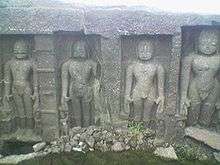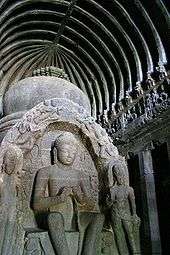Pandavleni Caves

Pandu Leni (also known as Trirashmi Caves and other variations) (Leni is Marathi word for caves), are a group of 24 caves carved between the 3rd century BC and the 2nd century AD, representing the Hinayana Buddhist caves and has nothing to do with the characters of Mahabharata (the Pandavas). Most of the caves are Viharas except for the 18th cave which is a Chaitya.[1] The location of the caves is a holy Buddhist site and is located about 8 km south of Nashik, Maharashtra, India.
Cave
The caves, known as Trirashmi Buddhist Caves (erroneosly known as Pandav Caves) were carved out from the 2nd century BCE till the 5th century CE as a part of donation by the Jain Kings, merchants and local people for the Buddhist monks. The name is derived from the word "Tiranhu" which is inscribed in the Caves.[2][3] It means "rays of sunlight" which is quite obvious referring to the rays of sunlight emerging from behind the Caves as seen from the village. These caves were carved and donated by various kings that ruled Nashik - The Satavahanas, The Nahapanas, The Abhirs. The caves lodge idols of Buddha and Bodhisattva. Some caves are intricately connected by stone-cut ladders that join them to the other caves. Steps lead to the caves from the bottom of the hill. The peak of the Trirashmi Caves is also accessible by trekking of about 20 mins but the path is well built with steps.[4]
These caves are the oldest caves of Maharashtra.. Some of the caves are large and contain numerous chambers - these rock-cut caves served as a viharas or monasteries for the disciples to meet and hear sermons. They contain interesting sculptures. One of the vihara caves is older and finer in sculptural detail and is thought to be nearly as old as the Karla Cave near Lonavala. Another cave (cave No. 18) is a Chaitya and is similar in age to the Karla Cave and has a particularly elaborate facade. Chaityas are used for chanting and meditation.
The cave has idols of Buddha, Jain Teerthankara Rishabhdev, and the icons of Bodhisatva, Veer Manibhadraji and Ambikadevi.[5][6]
The site has an excellent ancient water management system and skillfully chiseled out of solid rock are several attractive water tanks.[7]
History
The caves can be traced back up to 3rd century BC. Out of the twenty-four caves, two caves are a major attraction - the main cave which is the Chaitya (prayer hall) has a beautiful Stupa; the second one is cave no. 10 which is complete in all structural as well inscriptions. Both the caves have carvings and inscriptions also. The caves are facing eastwards. So it is recommended to visit the caves early morning as in sunlight the beauty of carvings is enhanced.
The caves were called Pundru which in Pali language means "yellow ochre color". This is because the caves were the residence of Buddhist monks who wore "the chivara or the yellow robes". Later on, the word Pundru changed to Pandu Caves (as per Ancient Monuments Act 26 May 1909). Decades later people started calling it Pandav Caves - a misnomer which is used for every cave in India.
The various inscriptions confirm that Nashik in that period was ruled by 3 dynasties – the Western Kshatrapas, the Satavahanas and the Abhiras. It seems there was always a conflict between Satavahanas and the Kshatrapas over supremacy. However, all the 3 kings fully supported Buddhism though they were not Buddhist in real sense. The inscriptions also confirm that apart from the kings, local merchants, landlords too supported and donated huge sums for the development of these caves.
The inscriptions of cave no.10 reveal that in 105-106 BC, Kshatrapas defeated the Satavahanas after which Kshatrapa Nahapana’s son-in-law and Dinika’s son- Ushavadata donated 3000 gold coins for this cave as well as for the food and clothing of the monks. Usabhdatta’s wife (Nahapana’s daughter), Dakshmitra also donated one cave for the Buddhist monks.
Attractions
Inscriptions in caves 3, 11, 12, 13, 14, 15, 19 and 20 are legible. Cave 15 - 'Sri Yajna Vihar' inscription mentions Sri Yajna Satkarni, the last powerful Satvahana King who ruled over the western Maharashtra. Similar inscription in cave 3 at Kanheri. This means probably the cave was carved during the beginning of the 3rd century AD. Other inscriptions note the names Bhattapalika, Gautamiputra Satkarni, Vashishthiputra Pulumavi of the Satavahanas and two of the Kshatrapas, Dakshamitra and Ushavadant. Cave 10 - 'Nahapana Vihara' is spacious with 16 rooms.
Since the caves were inhibited by the Mahayana as well as the Hinayana sects of Buddhism, one can see a nice confluence of structural and carvings.
Routes
The caves are located high in the mountains of Trirashmi. Some caves are intricately connected by stone-cut ladders that join them to the other caves. Steps lead to the caves from the bottom of the hill. The peak of the Trirashmi Caves is also accessible by trekking of about 20 mins but the path is treacherous and dangerous.[8]
Gallery
 A vihara cave
A vihara cave- Prayer hall
- Chaitya cave 18
- Statue of Buddha
 Statues of Jain Tirthankars
Statues of Jain Tirthankars Statues of Jain Tirthankars
Statues of Jain Tirthankars Rishabh dev
Rishabh dev
See also
- Gavi Gangadhareshwara Temple in Bangalore - also a cave temple
- Varaha Cave Temple
- Badami Cave Temples
- Undavalli caves
- Karla Caves
- Narthamalai
- Kaviyoor
- Indian rock-cut architecture
- Pandavleni
References
- ↑ lonelyplanet
- ↑ https://www.maharashtratourism.gov.in/treasures/caves
- ↑ http://www.nashikonline.in/city-guide/pandavleni-caves-of-nashik
- ↑ "Trirashmi Buddhist Caves". showcaves.com. Retrieved 2006-09-16.
- ↑ http://www.ajanta-ellora.com/pandavleni-caves.html
- ↑ http://www.maharashtratourism.net/caves/pandavleni-caves.html
- ↑ "Pandavleni Caves". india9. Retrieved 2006-09-16.
- ↑ https://web.archive.org/web/20090107034705/http://www.yotreks.com/Sahyadri/Caves/Pandavleni.html. Archived from the original on January 7, 2009. Retrieved March 16, 2008. Missing or empty
|title=(help)
- Inscriptions on Cave 10, 13, 15, 16
- Maharashtratil Buddha Dhammacha Itihas
- M.S.More
- Leni Maharashtrachi
- Dawood Dalvi
- http://asi.nic.in/asi_monu_tktd_maha_pandulenacaves.asp
External links
| Wikimedia Commons has media related to Pandavleni Caves. |
Coordinates: 19°56′23″N 73°44′55″E / 19.93959°N 73.74849°E


